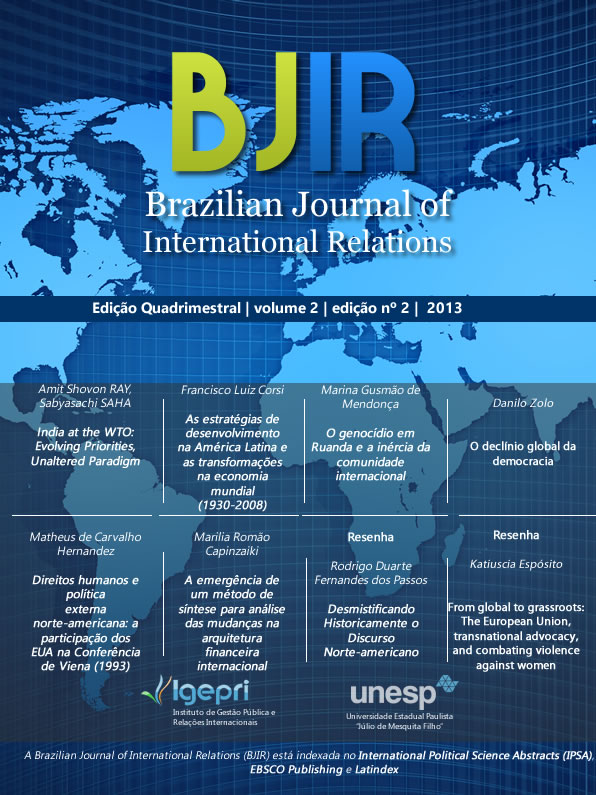A emergência de um método de síntese para análise das mudanças na arquitetura financeira internacional / The emergence of a synthesis method for analysis of changes in the international financial architecture
DOI:
https://doi.org/10.36311/2237-7743.2013.v2n2.p352-384Resumo
O campo da Economia Política Internacional compreende discussões diversas sobre a interdependência e o papel desempenhado pelas instituições, além de questões sobre as relações entre o poder político e o poder financeiro e monetário. Nesse contexto, é correto dizer que instituições como o Banco Mundial e o FMI se encaixam numa Ordem Internacional mais ampla, profundamente influenciada pela potência que emergiu como a principal construtora dessa ordem no período que se seguiu à Segunda Guerra: os EUA. Entretanto, a crise financeira que eclodiu em 2008 impulsionou questionamentos a respeito da estrutura de governança global econômica estabelecida, além de desencadear uma crise de legitimidade em relação ao contexto em que atuam os braços dessa governança. Dessa forma, o presente artigo buscará considerar criticamente a Teoria dos Regimes de Keohane e a Teoria Crítica da Economia Política Internacional, buscando aplicá-las às dinâmicas de mudança na Ordem Econômica Internacional e, especificamente, ao recente projeto de reforma do FMI. O fortalecimento de arranjos fora da institucionalidade tradicional, tais como o recente projeto de criação de um banco dos BRICS e o G20, cuja atuação foi decisiva para a concretização de diversos aspectos da reforma anunciada em 2010, podem ser interpretados como sintomas de uma alteração mais profunda no regime vigente. Ao mesmo tempo, as mudanças nas relações econômicas internacionais podem se inserir numa perspectiva mais ampla, também passível de ser explicada pela interdependência entre capacidades materiais, instituições e ideias, condizente com a Teoria Crítica de Cox. Assim, tem-se como objetivo explorar as possibilidades quanto à elaboração de um método de síntese que possa conduzir a análise das mudanças contemporâneas na arquitetura financeira internacional, da qual o FMI é peça-chave.
The field of International Political Economy comprises several discussions on interdependence and the role of institutions, as well as questions concerning the relationship between political power and financial and monetary power. Considering this context, it is correct to affirm that institutions such as the World Bank and the International Monetary Fund are part of a broader International Order, deeply influenced by the nation that has emerged as its leading builder in the period that followed the Second World War: the United States. However, the financial crisis that erupted in 2008 raised questions about the global economic governance structure, and triggered a legitimacy crisis regarding the environment in which those governance bodies operate. Thus, this article aims to critically consider the Regime Theory elaborated by Keohane, and Cox’s Critical Theory of IPE, seeking to apply them to the dynamics of change in the international economic order and, specifically, to the recent governance reform project carried out by IMF. The strengthening of institutional arrangements outside the traditional order, such as recent initiatives to create a BRICS’ bank and the performance of G20, which was crucial to the materialization of several aspects of the IMF reform announced in 2012, can be interpreted as symptoms of deeper changes in the current economic Regime. Simultaneously, changes in international economic relations can be seen through a broader perspective that could be explained by the interdependence between material capabilities, ideas and institutions, which is consistent with the Critical Theory formulated by Cox. Therefore, the goal is to explore the possibilities regarding the development of a synthesis method for the analysis of contemporary changes in the international financial architecture, from which the IMF is a key institution.







